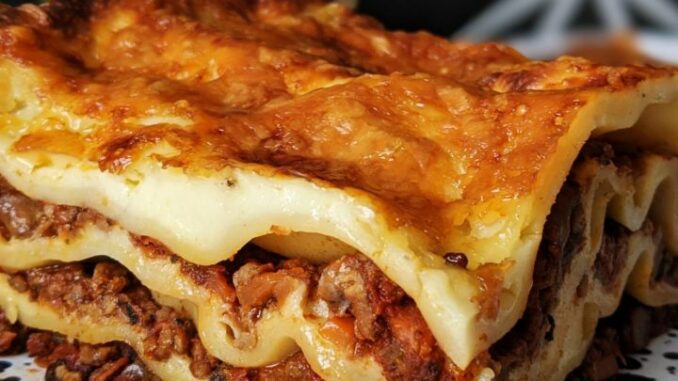
Introduction:
Lasagne, a culinary masterpiece from the heart of Italy, stands as a testament to the country’s rich gastronomic heritage. This beloved dish, characterized by layers of pasta, flavorful sauces, and decadent cheese, has transcended cultural boundaries to become a global symbol of comfort and indulgence. In this extensive exploration, we will delve into the history of Italian lasagne, tracing its origins and evolution through the ages. Additionally, we will unveil the secrets behind crafting the perfect lasagne, celebrating the interplay of textures and flavors that define this iconic dish.
Section 1: Origins and Ancient Inspirations
1.1 Ancient Precursors:
While the exact origin of lasagne is elusive, pasta dishes with layered components have ancient roots. Ancient Greeks are credited with creating Laganon, a type of pasta that could be considered an early ancestor of lasagne. The Romans further refined pasta-making techniques, influencing the development of layered pasta dishes in Italy.
1.2 Medieval Italy:
During the Middle Ages, the concept of layered pasta dishes gained prominence in Italy. Lasagne, as we know it today, began to take shape with the introduction of pasta layers interleaved with ingredients such as cheese and spices.
Section 2: The Renaissance and Culinary Innovations
2.1 Renaissance Influence:
The Renaissance era saw significant culinary advancements, and lasagne continued to evolve. The availability of tomatoes, a New World crop, in Italy during the 16th century marked a pivotal moment, leading to the creation of tomato-based sauces that would become integral to modern lasagne recipes.
2.2 Regional Variations:
Italy’s diverse regions contributed to the development of distinct lasagne variations. Northern Italy, for instance, embraced creamy béchamel sauces, while the south favored rich, tomato-based ragù sauces. Regional preferences influenced the choice of ingredients and techniques, creating a culinary tapestry of lasagne varieties.
Section 3: Essential Components of Lasagne
3.1 Fresh Pasta Sheets:
The foundation of any lasagne is its pasta sheets. While store-bought options are convenient, crafting fresh pasta at home ensures a tender, melt-in-your-mouth texture. Thin, wide sheets of pasta, often made with flour and eggs, are the ideal base for building layers.
3.2 Rich Meat or Vegetarian Sauce:
The sauce, a pivotal element, contributes layers of flavor to the lasagne. Classic meat-based ragù, made with a combination of ground beef and pork, or vegetarian alternatives with hearty vegetable or mushroom fillings, offer a versatile canvas for creativity.
3.3 Creamy Béchamel Sauce:
Béchamel sauce, a velvety concoction of butter, flour, and milk, adds a luxurious touch to lasagne. It provides a creamy contrast to the robustness of the meat or vegetable sauce, creating a harmonious balance of flavors and textures.
3.4 Cheese Medley:
Cheese is a quintessential component, adding richness and depth to lasagne. A blend of Parmesan, mozzarella, and ricotta is a classic combination, creating layers of gooey, melty goodness.
Section 4: Crafting the Perfect Lasagne – Step-by-Step Recipe
4.1 Ingredients:
- Fresh lasagne sheets (homemade or store-bought)
- 1 pound ground beef (or a mix of beef and pork)
- 1 onion, finely chopped
- 2 cloves garlic, minced
- 1 can (28 oz) crushed tomatoes
- 2 tablespoons tomato paste
- 1 teaspoon dried oregano
- Salt and pepper to taste
- 2 cups ricotta cheese
- 1 cup grated Parmesan cheese
- 2 cups shredded mozzarella cheese
- 4 cups béchamel sauce
- Fresh basil for garnish
4.2 Instructions:
- In a skillet, sauté the onions and garlic until softened. Add the ground meat and cook until browned. Stir in crushed tomatoes, tomato paste, oregano, salt, and pepper. Simmer for 20-30 minutes, allowing the flavors to meld.
- Preheat the oven to 375°F (190°C). In a baking dish, spread a thin layer of the meat sauce.
- Place a layer of fresh lasagne sheets over the sauce. Add a layer of béchamel sauce, followed by ricotta, Parmesan, and mozzarella cheeses.
- Repeat the process, layering until you run out of ingredients. Ensure the final layer is topped with a generous amount of cheese.
- Cover the baking dish with foil and bake for 25-30 minutes. Remove the foil and bake for an additional 10-15 minutes until the cheese is golden and bubbly.
- Allow the lasagne to rest for 10 minutes before serving. Garnish with fresh basil.
4.3 Note on Presentation:
For an authentic touch, serve lasagne directly from the baking dish, allowing guests to witness the layers of goodness. Pair it with a crisp salad and a glass of red wine for a complete Italian dining experience.
Section 5: Lasagne in Contemporary Cuisine
5.1 Fusion Inspirations:
In modern gastronomy, chefs experiment with creative twists on traditional lasagne. From seafood variations to plant-based alternatives using zucchini or eggplant as pasta substitutes, contemporary interpretations celebrate innovation while honoring the dish’s roots.
5.2 Health-Conscious Choices:
As dietary preferences evolve, lasagne recipes adapt to cater to health-conscious eaters. Whole wheat or gluten-free pasta, leaner meat options, and increased vegetable content offer lighter alternatives without compromising on flavor.
Section 6: Lasagne in Popular Culture
6.1 Cinematic and Culinary Presence:
Lasagne has made significant appearances in popular culture, solidifying its place in the culinary landscape. From the charming scenes in “Lady and the Tramp” to celebrated moments in iconic Italian-American films, lasagne has become more than a dish—it is a cultural touchstone.
6.2 Celebrated Events:
Events like National Lasagne Day and Lasagne Week celebrate the dish’s global popularity. Restaurants, home cooks, and culinary enthusiasts come together to share their love for lasagne through festivals, competitions, and communal gatherings.
Conclusion:
Lasagne, with its layers of pasta, rich sauces, and gooey cheese, encapsulates the essence of Italian comfort food. From its ancient origins to its global popularity, lasagne remains a culinary marvel that transcends time and borders. As you embark on your lasagne-making journey, whether following a traditional recipe or adding your creative flair, savor the layers of history and flavor in each bite. May your lasagne be a celebration of the enduring charm of Italian cuisine. Buon Appetito!